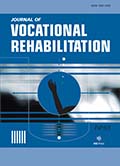Authors: Hemmeter, Jeffrey | Kauff, Jacqueline | Wittenburg, David
Article Type:
Research Article
Abstract:
This paper provides an analysis of the dynamics of the transition of child Supplemental Security Income (SSI) recipients into adulthood using linked 2001–2002 National Survey of SSI Children and Families (NSCF) survey and Social Security Administration (SSA) administrative data. We examine the interaction of impairment status, reported health needs, and other self-reported indicators of human capital on SSI program and employment outcomes after age 18. Our primary objective is to examine the differences in
…pre-age-18 individual characteristics across subgroups of recipients by impairment status and determine whether these differences influence post-age-18 SSI participation and employment outcomes. We find that after controlling for measures of disability severity, duration, and human capital, youth with behavioral disorders and mental disorders other than mental retardation are much less likely to receive SSI at age 19. The findings also suggest that non-health factors, particularly education, employment, and social indicators, play an important role in the probability of a child SSI recipient being on adult SSI after age 18. Our findings indicate that, while some youth appear to be making a successful transition from child SSI benefits to adult benefits or other activities (off of SSI), others appear to have limited prospects for long-term self-sufficiency. A major concern is that some youth no longer on SSI after age 18, particularly those with behavioral disorders and mental disorders other than mental retardation, may not have been sufficiently prepared for life without SSI.
Show more
Keywords: Supplemental Security Income, SSI, transition, youth, disabilities, social security, SSA, age 18 redetermination, National Survey of SSI Children and Families (NSCF)
DOI: 10.3233/JVR-2009-0462
Citation: Journal of Vocational Rehabilitation,
vol. 30, no. 3, pp. 201-221, 2009
Price: EUR 27.50





